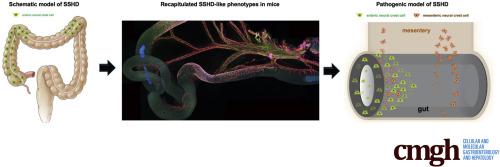Cellular and Molecular Gastroenterology and Hepatology ( IF 7.1 ) Pub Date : 2020-12-16 , DOI: 10.1016/j.jcmgh.2020.12.010 Qi Yu 1 , Mengjie Du 1 , Wen Zhang 2 , Li Liu 1 , Zhigang Gao 3 , Wei Chen 4 , Yan Gu 1 , Kun Zhu 5 , Xueyuan Niu 1 , Qiming Sun 6 , Liang Wang 1

|
Background & Aims
Defective rostrocaudal colonization of the gut by vagal neural crest cells (vNCCs) results in Hirschsprung's disease (HSCR), which is characterized by aganglionosis in variable lengths of the distal bowel. Skip segment Hirschsprung’s disease (SSHD), referring to a ganglionated segment within an otherwise aganglionic intestine, contradicts HSCR pathogenesis and underscores a significant gap in our understanding of the development of the enteric nervous system. Here, we aimed to identify the embryonic origin of the ganglionic segments in SSHD.
Methods
Intestinal biopsy specimens from HSCR patients were prepared via the Swiss-roll technique to search for SSHD cases. NCC migration from the neural tube to the gut was spatiotemporally traced using targeted cell lineages and gene manipulation in mice.
Results
After invading the mesentery surrounding the foregut, vNCCs separated into 2 populations: mesenteric NCCs (mNCCs) proceeded to migrate along the mesentery, whereas enteric NCCs invaded the foregut to migrate along the gut. mNCCs not only produced neurons and glia within the gut mesentery, but also continuously complemented the enteric NCC pool. Two new cases of SSHD were identified from 183 HSCR patients, and Ednrb-mutant mice, but not Ret-/- mice, showed a high incidence rate of SSHD-like phenotypes.
Conclusions
mNCCs, a subset of vNCCs that migrate into the gut via the gut mesentery to give rise to enteric neurons, could provide an embryologic explanation for SSHD. These findings lead to novel insights into the development of the enteric nervous system and the etiology of HSCR.
中文翻译:

肠系膜神经嵴细胞是先天性巨结肠的胚胎学基础
背景与目标
迷走神经嵴细胞 (vNCCs) 对肠道的有缺陷的 rostrocaudal 定植导致先天性巨结肠 (HSCR),其特征是远端肠道长度不等的神经节组织增生症。跳过节段先天性巨结肠 (SSHD) 是指在其他神经节小肠内的神经节段,它与 HSCR 发病机制相矛盾,并强调了我们对肠神经系统发育的理解存在重大差距。在这里,我们旨在确定 SSHD 中神经节段的胚胎起源。
方法
来自 HSCR 患者的肠道活检标本是通过 Swiss-roll 技术制备的,以搜索 SSHD 病例。使用靶向细胞谱系和小鼠基因操作对 NCC 从神经管到肠道的迁移进行时空追踪。
结果
在侵入前肠周围的肠系膜后,vNCCs 分为 2 个群体:肠系膜 NCCs (mNCCs) 继续沿肠系膜迁移,而肠道 NCCs 侵入前肠沿肠道迁移。mNCCs 不仅在肠系膜内产生神经元和神经胶质,而且还不断补充肠道 NCC 池。从 183 名 HSCR 患者中发现了 2 例新的 SSHD 病例,Ednrb突变小鼠(而非Ret -/-小鼠)显示出高发生率的 SSHD 样表型。
结论
mNCCs 是 vNCCs 的一个子集,它通过肠系膜迁移到肠道中以产生肠神经元,可以为 SSHD 提供胚胎学解释。这些发现导致对肠神经系统发育和 HSCR 病因学的新见解。











































 京公网安备 11010802027423号
京公网安备 11010802027423号